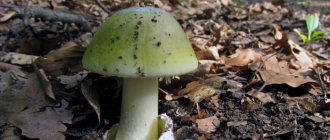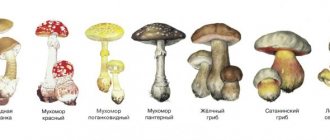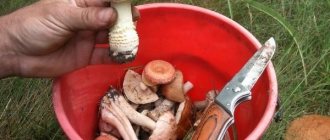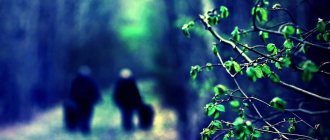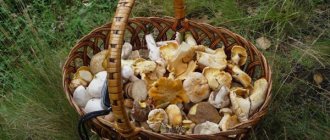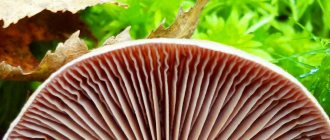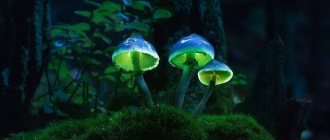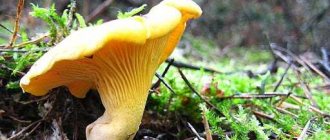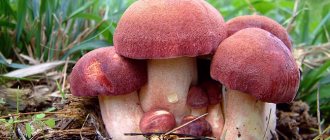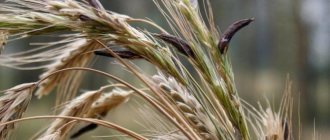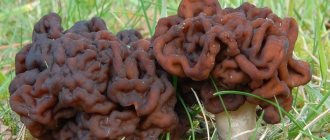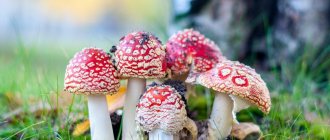What is the most important thing for a mushroom picker who goes into the forest on a “silent hunt”? No, not a basket at all (although you will also need that), but knowledge, especially regarding which mushrooms are poisonous and which ones can be safely put in the basket. Without them, an outing for a forest delicacy can smoothly turn into an urgent trip to the hospital. In some cases it will turn into the last walk of your life. To avoid disastrous consequences, we bring to your attention brief information about dangerous mushrooms that should not be cut off under any circumstances. Take a closer look at the photos and forever remember how they look. So let's begin.
The most dangerous mushroom is toadstool
Among poisonous mushrooms, the first place in toxicity and frequency of fatal poisoning is occupied by toadstool. Its venom is stable before heat treatment, and also has delayed symptoms. After tasting mushrooms, you can feel like a completely healthy person for the first day, but this effect is deceptive. While precious time is running out to save a life, toxins are already doing their dirty work, destroying the liver and kidneys. From the second day, symptoms of poisoning manifest themselves as headache and muscle pain, vomiting, but time is lost. In most cases, death occurs.
Even just for a moment touching the edible mushrooms in the basket, the poison of the toadstool is instantly absorbed into their caps and legs and turns the harmless gifts of nature into a deadly weapon.
The toadstool grows in deciduous forests and in appearance (at a young age) slightly resembles champignons or greenfinches, depending on the color of the cap. The cap can be flat with a slight convexity or egg-shaped, with smooth edges and ingrown fibers. The color varies from white to greenish-olive, the plates under the cap are also white. The elongated leg at the base expands and is “shackled” in the remains of a film-bag, which hid a young mushroom underneath, and has a white ring on top.
In a toadstool, when broken, the white flesh does not darken and retains its color.
Waxy talker
The size of the cap is about 5-11 cm, the thin stem is up to 5-8 cm high. The cap is white, smooth, slightly shiny, hence the name “waxy”.
It is especially dangerous for sick people, the elderly or young children. It is easier for a healthy person to tolerate its poisoning. Symptoms of poisoning with poisonous mushrooms appear quite quickly from 30 minutes to 6 hours. Nausea, vomiting, fever. You should immediately consult a doctor if you have suddenly eaten any mushrooms you have cut yourself.
Such different fly agarics
Even children know about the dangerous properties of fly agaric. In all fairy tales it is described as a deadly ingredient in the preparation of a poisonous potion. It’s so simple: the red-headed mushroom with white spots, as everyone saw it in illustrations in books, is not at all a single specimen. Besides it, there are other varieties of fly agaric that differ from each other. Some of them are very edible. For example, Caesar mushroom, ovoid and blushing fly agaric. Of course, most species are still inedible. And some are life-threatening and it is strictly prohibited to include them in the diet.
The name “fly agaric” is made up of two words: “flies” and “pestilence”, that is, death. And without explanation, it is clear that the mushroom kills flies, namely its juice, which is released from the cap after sprinkling it with sugar.
Deadly poisonous fly agaric species that pose the greatest danger to humans include:
- Poisonous (red). Grows in forests under birch and spruce trees. The globular cap is most often bright red, although there are also orange varieties. A rich scattering of large growths is visible across the entire surface, however, they are weakly adherent and are washed off after rain. The flesh is dense, white, with a subtle mushroom aroma. The white leg is tall, strong and powerful, with the remains of a cap in the form of flakes (also white).
- Panther (leopard). It lives among pine trees and is distinguished by a characteristic spotted cap of a brownish color with white growths. The pulp is white, watery, and smells like fresh radish. The leg is cream-colored, twice ringed in the lower part, the walls are quite thick, but have a hollow space inside.
- White stinking (often called white toadstool by mushroom pickers). It grows among the hills in deciduous-coniferous forests, is distinguished by the specific white color of the entire mushroom body and the pungent smell of bleach, for which it is named. The surface of the cap is most often shiny, but sometimes large white flakes are visible on it. The long stalk is almost always curved, with a tuberous base.
- Bright yellow (lemon). Grows mainly on sandy soil. The owner of a yellow hat with a smooth skin, sometimes sparse white flakes are visible on it. The light leg is squat and fragile, with a thick ring at the bottom.
Application
In cooking
Eating toadstool is strictly prohibited. It is classified as a highly toxic species of mushroom, but the edible fly agaric or caesarean mushroom is quite edible and has a pleasant taste.
It is used to prepare various culinary delights. It is not suitable for winter preparations. The broths taste like broths made from summer mushrooms. Their mushroom smell is weak.
Umbrellas - maiden, walnut and variegated - are mostly used for drying. Mushroom pickers claim that their caps have a piquant taste and a pleasant aroma when dried.
In medicine
Lamellar species of mushrooms are actively used in folk medicine and unconventional movements. For example, homeopaths prepare infusions from poisonous plants and mushrooms. They are sure that in small quantities poison is of disproportionate benefit to the body. Traditional healers make tinctures.
Treatment with drugs for their poisons is dangerous. Before use, carefully read the instructions with the names of the substances included in the medicine. Do not start treatment with homeopathic remedies without consulting a doctor in a regular hospital.
An antidote is also produced from the pale toadstool, which neutralizes the poison of any variety of the pale toadstool. The medicine is still not developed and thousands of people die from poisoning every year. Lethal dose: 30 g. The only chance to escape is to seek help in time.
Small but deadly ragged mushroom
The poisonous mushroom got its name from its peculiar structure: often its cap, the surface of which is covered with silky fibers, is also decorated with longitudinal cracks, and the edges are torn. In the literature, the mushroom is better known as fiber and has a modest size. The height of the leg is slightly more than 1 cm, and the diameter of the hat with a protruding tubercle in the center is a maximum of 8 cm, but this does not prevent it from remaining one of the most dangerous.
The concentration of muscarine in the pulp of the fiber exceeds the red fly agaric, and the effect is noticeable within half an hour, and within 24 hours all symptoms of poisoning with this toxin disappear.
Chemical composition
The composition of the pale toadstool includes phalloidins (phallotoxins), amanitins (amatoxins and amanitotoxins) - poisons, an insignificant dose of which leads to poisoning. These are poisons with varying durations of action, but not always a bad outcome for the creatures that taste them.
Red fly agaric contains muscarine, ibotenic acid and muscimol, which act on the psyche and even in large doses cause the death of brain cells.
Beautiful, but “crappy mushroom”
This is exactly the case when the title matches the content. It’s not for nothing that the false valu mushroom or horseradish mushroom is called such an indecent word by the people - not only is it poisonous, but also the flesh is bitter, and the smell it emits is simply disgusting and not at all mushroom-like. But thanks to its “aroma”, it will no longer be possible to gain the trust of a mushroom picker under the guise of russula, which valui is very similar to.
The scientific name of the mushroom is “hebeloma adhesive.”
False tree grows everywhere, but most often it can be seen at the end of summer on the light edges of coniferous and deciduous forests, under oak, birch or aspen. The cap of a young mushroom is creamy-white, convex, with the edges turned down. With age, its center bends inward and darkens to a yellow-brown color, while the edges remain light. The skin on the cap is nice and smooth, but sticky. The bottom of the cap consists of adherent plates that are gray-white in young valuei and dirty yellow in old specimens. The dense, bitter pulp also has a corresponding color. The leg of the false valuu is quite high, about 9 cm. It is wide at the base, tapers further upward, and is covered with a white coating similar to flour.
A characteristic feature of the “horseradish mushroom” is the presence of black inclusions on the plates.
Advice from mycologist M. Vishnevsky
Russia is very rich and prolific in various delicious mushrooms. And has one of the largest consumption in the country. In some countries, mushrooms are not eaten at all. In Russia, approximately one person per year consumes about 10 kg of various mushrooms.
To ensure that this tasty and healthy protein-rich product brings only benefits, Mikhail Vishnevsky, the chief mycologist of Russia, advises adhering to the following principles:
- Show mushrooms that are new to you to an experienced mushroom picker, or it’s better not to pick them at all
- collect already known and proven species
- collect in cleaner ecological places, no need to cut near the roadway, near factories or chemical zones and fields. They use chemicals to poison insects.
- do not forget to look at the color, appearance, shape and smell of the whole mushroom, as well as when broken
- Do not handle obviously poisonous ones, such as toadstools, with your bare hands. This is especially true for children because... for example, the fly agaric is very beautiful and attractive
- do not take shortcuts in an unknown new area, for example when traveling to a new place on vacation
- Before starting cooking, carefully sort through and discard any suspicious-looking old or rotten
- follow the cooking process fully
- Do not give dishes with mushrooms to children under 6-7 years old and the elderly
- Any suspicion of poisoning - call the hospital immediately
That's all the basic rules. We wish you clear weather.
The poisonous twin of summer honey mushrooms: sulfur-yellow honey fungus
Everyone knows that honey mushrooms grow on stumps in friendly flocks, but among them there is a “relative” that looks practically no different from tasty mushrooms, but causes severe poisoning. This is a false sulfur-yellow honey fungus. Poisonous lookalikes live in clusters on the remains of tree species almost everywhere, both in forests and in clearings between fields.
The mushrooms have small caps (maximum 7 cm in diameter) of gray-yellow color, with a darker, reddish center. The pulp is light, bitter and smells bad. The plates under the cap are tightly attached to the stem; in the old mushroom they are dark. The light leg is long, up to 10 cm, and smooth, consisting of fibers.
You can distinguish between “good” and “bad honey fungus” by the following characteristics:
- The edible mushroom has scales on its cap and stem, while the false mushroom does not;
- The “good” mushroom is dressed in a skirt on a leg, the “bad” one does not have one.
Vital activity of caps
Stages of development:
- Vegetative . Associated with the accumulation of nutrients and preparation for germination.
- Reproductive – direct growth of the fruiting body from the primordium to final formation. The average duration of this period is 2 weeks.
If the mushroom has not been cut, it smolders and thus additionally feeds the mycelium.
The life activity of cap mushrooms is closely related to weather conditions. They grow well in moist and warm environments. With the first warming and rains, morels sprout at the end of April or beginning of May, followed by champignons. If the weather is dry, the mushrooms will germinate only in mid-summer. And with the arrival of early cold weather, their growth stops.
Satanic mushroom disguised as boletus
The massive stem and dense flesh of the satanic mushroom make it look like a porcini mushroom, but eating such a beauty is fraught with severe poisoning. Satanic bolete, as this species is also called, tastes quite good: there is no smell, no bitterness characteristic of poisonous mushrooms.
Some scientists even classify bolet as a conditionally edible mushroom if it is subjected to prolonged soaking and prolonged heat treatment. But no one can say exactly how many toxins boiled mushrooms of this type contain, so it’s better not to risk your health.
Externally, the satanic mushroom is quite beautiful: the dirty white cap is fleshy, with a spongy yellow bottom that turns red over time. The shape of the leg is similar to a real edible boletus, just as massive, in the shape of a barrel. Under the cap, the stem becomes thinner and turns yellow, the rest is orange-red. The flesh is very dense, white, only pinkish at the very base of the stem. Young mushrooms have a pleasant smell, but older specimens give off a disgusting smell of spoiled vegetables.
You can distinguish Satanic boletus from edible mushrooms by cutting the flesh: when it comes into contact with air, it first acquires a red tint and then turns blue.
First aid for poisoning
Gastric lavage is the most important thing to do at the first suspicion of poisoning with poisonous mushrooms. This procedure can be done at home. It must be repeated up to 5 times. The victim should drink at least 5-6 glasses of water, and then artificially vomit. To do this, take a spoon and press on the root of your tongue.
After these manipulations, the patient is sent to bed, his limbs are covered with warm heating pads, and he is given strong black tea. At the first stage (shortly after eating poisonous mushrooms), in the absence of diarrhea, mild laxatives are given. It is necessary to monitor your blood pressure to prevent a sharp drop, which laxatives can lead to by dehydrating the body.
Next, it is advisable to use absorbent drugs, the most common of which is activated carbon. It is able to remove toxins and neutralize the body.
All these actions should be done immediately until the ambulance arrives, which must be called in advance.
How many times have we told the world how dangerous poisonous mushrooms are, but, unfortunately, not all people behave wisely when eating dubious species. No one is calling for giving up mushrooms, because it is enough to learn to correctly recognize them, and the risk of getting poisoned will be reduced to zero.
0
4
Copy link
Svinushki - mushrooms similar to milk mushrooms
The debate about the edibility of pig mushrooms was stopped in the early 90s, when all types of these mushrooms were officially recognized as dangerous to human life and health. Some mushroom pickers continue to collect them for food to this day, but this should not be done under any circumstances, since pig toxins can accumulate in the body and symptoms of poisoning do not appear immediately.
Externally, poisonous mushrooms are similar to milk mushrooms: they are small, with squat legs and a fleshy round cap of a dirty yellow or gray-brown color. The center of the hat is deeply concave, the edges are wavy. The fruit body is yellowish in cross section, but quickly darkens from the air. Pigs grow in groups in forests and plantings; they especially love wind-fallen trees, located among their rhizomes.
There are more than 30 varieties of pig's ear, as the mushroom is also called. All of them contain lectins and can cause poisoning, but the thinnest pig is considered the most dangerous. The cap of a young poisonous mushroom is smooth, dirty olive, and becomes rusty over time. The short leg has the shape of a cylinder. When the mushroom body is broken, a distinct smell of rotting wood is heard.
The following pigs are no less dangerous:
- Alder. The cap is brown-yellow with small scales, the edges are slightly pubescent, the funnel is small. The leg is short, tapering downward.
- Fat. The velvety brown cap is quite large and tongue-like. The stem is a little fleecy and is almost always attached not in the center, but closer to the edge of the hat. The pulp is watery, odorless.
- Ear-shaped. The small leg merges with a hard fan-shaped cap of dark yellow color with a brown tint. Grows on conifer stumps and logs.
Reproduction
Division is carried out using spore cells. The fruiting bodies of cap mushrooms serve to produce spores; they are formed:
- In the cavity of the tubes;
- between the plates of the cap, which radiate away from the center.
After ripening, the spores spill out and spread over long distances with the help of the wind. Insects carry spores on their legs throughout the forest, and they are also carried by rodents that feed on mushrooms. The spores are not destroyed by gastric juice and enzymes, they simply come out along with other undigested food debris.
Once on soil enriched with organic matter and moisture, the spores take root and give life to new organisms. First, the threads of the mycelium branch. This process is very slow. Only after reaching the required length and accumulating a sufficient amount of nutrients does the formation of a fruiting body begin. Fruiting bodies begin to appear in the first days of May, but rapid development and growth are possible after the onset of rains.
How do cap mushrooms reproduce?
Poisonous umbrellas
Slender mushrooms on tall, thin stalks with flat, wide-open caps resembling an umbrella grow in abundance along roads and roadsides. They are called umbrellas. The cap actually opens up and becomes wider as the mushroom grows. Most varieties of umbrella mushrooms are edible and very tasty, but there are also poisonous specimens among them.
The most dangerous and common poisonous mushrooms are the following umbrellas:
- Comb. The reddish flat cap of an adult mushroom has a slight convexity in the center. The entire surface is covered with sparse orange scales, similar to scallops, and there is a light fringe along the edge. The stem is hollow, thin, yellowish in color; in young mushrooms it is ringed, but the ring quickly breaks.
- Chestnut. It is distinguished by a darker, almost brown, color of the cap and a large number of pronounced scales, also dark in color. The long leg with reddish flesh has a similar color.
How to distinguish russula
very unpretentious - they can be found in almost any area. Russulas have multi-colored caps - pink, red, yellow, brownish, greenish, always without spots or dots. The skin is easily removed from them, and the stem is white and easily broken. In poisonous counterparts, the flesh is denser and more elastic, has a pink color, there is a reddened or darkened soft film on the stem, and there are spots and dots on the cap. The main difference from normal russula is its unpleasant and bitter taste.
Interesting read: Chanterelle mushroom: where and how to collect it correctly
Poisonous rows
Row mushrooms have many varieties. Among them there are both edible and very tasty mushrooms, as well as frankly tasteless and inedible types. There are also very dangerous poisonous rows. Some of them resemble their “harmless” relatives, which easily misleads inexperienced mushroom pickers. Before you go into the forest, you should look for a person to be your partner. He must know all the intricacies of the mushroom business and be able to distinguish “bad” rows from “good” ones.
The second name for the rows is govorushki.
Among the poisonous talkers, the following rows are considered one of the most dangerous, capable of causing death:
- Whitish (aka discolored). In terms of toxin content, it is ahead of poisonous fly agaric mushrooms, in particular red fly agarics. Grows on lawns. Young mushrooms have a slightly convex white cap. Over time, it levels out, and in old rows it turns in the opposite direction. The low, thin stem and fibrous flesh are painted white, which does not darken after cutting.
- Tiger (aka leopard). Grows on calcareous soils among conifers and deciduous trees. The gray cap is curved down; there are abundant, darker scales over the entire surface. The plates under the hat are also white and thick. The leg is slightly lighter, plain, without flakes, narrowed at the bottom. The pulp is dense, slightly yellowish, and smells like flour.
- Pointed (aka mouse or hot-sharp). It grows in coniferous forests and is distinguished by the presence of a characteristic sharp tip on the cap and shiny gray skin. The leg is long, white, with a yellow tint (less often pink) appearing at the root. The fruit body is white, odorless, but with a very pungent taste. No need to try!
Nutrition
The cells of cap mushrooms lack plastids with chlorophyll and are not able to independently synthesize organic substances. They consume only prepared foods that are absorbed by mycelium threads from moist soil. This is how they adsorb mineral salts, water, and nutrients.
Some mushrooms use the roots of the trees they grow near to feed. Most caps are saprotrophs, meaning they obtain organic compounds by breaking down the remains of dead plants or animals.
Why many cap mushrooms can only grow near trees?
This is due to the symbiotic relationship between tree roots and fungal hyphae. During this form of cohabitation, both organisms benefit from it.
The mycelium surrounds the root with its hyphae and grows through the wall of its cells. When the mycelium absorbs moisture and mineral salts from the ground, they also move into the root system of the tree. The old parts of the root are devoid of root hairs, and the fungal threads seem to replace them. From the root of the tree, the mushroom takes in already synthesized organic substances that are needed for nutrition and growth of the fruiting body.
Gall mushroom: inedible or poisonous?
Most scientists classify the gall mushroom as inedible, since even forest insects do not dare to taste its bitter pulp. However, another group of researchers is convinced that this mushroom is poisonous. If the dense pulp is eaten, death does not occur. But the toxins it contains in large quantities cause enormous harm to internal organs, in particular the liver.
People call the mushroom bitter for its unique taste.
The size of the poisonous mushroom is not small: the diameter of the brown-orange cap reaches 10 cm, and the creamy-red leg is very thick, with a darker mesh-like pattern in the upper part.
The gall mushroom is similar to the white one, but, unlike the latter, it always turns pink when broken.
Yellow-skinned champignon
The cap size is about 5-14 cm, the stem is thin, the height is about 6-11 cm. The cap is white.
The difference from regular champignon is that the flesh turns yellow when pressed with a finger or broken. Hence the name “yellow-skinned”. Causes mild poisoning, but of course everything depends on the dose. Wide range of growing habitats available to people. These are not only deciduous forests, but also all kinds of parks and alleys where there are trees and tall grass. Therefore, you need to be especially careful with this species. Even children walking in the park can find and pick them.
Fragile impatiens galerina swamp
In marshy areas of the forest, in thickets of moss, you can find small mushrooms on a long thin stalk - marsh galerina. The brittle light yellow leg with a white ring at the top can be easily knocked down even with a thin twig. Moreover, the mushroom is poisonous and should not be eaten anyway. The dark yellow cap of the galerina is also fragile and watery. At a young age it looks like a bell, but then straightens, leaving only a sharp bulge in the center.
This is not a complete list of poisonous mushrooms; in addition, there are many false species that can easily be confused with edible ones. If you are not sure which mushroom is under your feet, please pass by. It’s better to take an extra lap through the forest or return home with an empty wallet than to suffer from severe poisoning later. Be careful, take care of your health and the health of those close to you!
Tips for mushroom pickers
To succeed in “silent hunting,” novice mushroom pickers need to follow some tricks that experienced seekers are happy to share. The following 5 tips will help you not only fill your baskets to the top, but also enjoy the picking process:
- Before going into the forest, you need to take care of your equipment. The mushroom picker's clothing should be closed so that it can reliably protect against annoying insects, ticks, and also prevent injury from protruding branches. Also, we must not forget about comfortable shoes, because you will have to walk a lot.
- When going for mushrooms, you need to take with you a phone, a compass, a watch, a lighter or matches, as well as a small supply of water and food. This is the minimum set that can save a life in the forest if a mushroom picker gets into a difficult situation, for example, gets lost.
- For mushrooms, it is better to take a wicker basket, as they can break and even turn sour in a bag. The knife should be sharp and compact.
- It is recommended to look for mushrooms in small forest plantings, on forest edges, on the banks of ditches and on other outskirts. There is no point in going deep into the forest - mushrooms are much less common there. It is important to avoid places near highways and factories, since mushrooms absorb all harmful substances from the air.
- Under no circumstances should you take a mushroom whose edibility is in doubt.
A useful reminder for mushroom pickers
To summarize, let’s note the main thing: without the appropriate theoretical knowledge and practical experience, you should not go into the forest to pick mushrooms on your own. But you don’t have to give up your favorite dish. In this case, you can buy mushrooms in a store where their quality and origin are already known. And if the desire to go on a quiet hunt persists, a beginner should take with him a guide to mycology. Such an assistant will be simply indispensable in the forest and will help determine the edibility of any mushroom.
Do you pick mushrooms? How do you distinguish poisonous ones? Share your experience in the comments.
